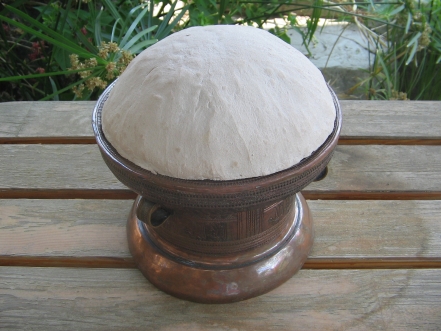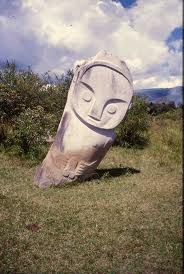Nguyễn Xuân Quang (BP63)
.

In Teju Island, South Korea there are phallic or mushroom shaped ancestor stone statues called dol hareubang. The hats of these statues are commonly referred to as phallic or mushroom-like. Nowadays, these dol hareubangs are the symbols of Teju Island.
Dol hareubang, Teju Island, South Korea (author’s picture).
Author and dol hareubangs, Teju Island.
The name dol hareubang derives from the Korean word for “stone” (dol 돌) plus the Jeju dialect word hareubang(하르방) meaning “grandfather” or “senior” (harabeoji [할아버지] in Standard Korean) and was coined in the mid-20th century…
At present time, they are considered to be gods offering both protection and fertility and were placed outside of gates for protection against demons travelling between realities.
There are three main theories as to the origin of dol hareubangs ; either that they were introduced by visitors from the sea, that they are a counterpart to the jangseungs (totem poles) of mainland Korea, or that they spread with shamanic mushroom culture.
Halla San (in Teju) has been named in Korean literature as one of the “Sam Shin San” (삼신산/ 三神山), or one of the Three Spirit Mountains. Each of these mountains are considered gateways to the spirit world, and have the Amanita muscaria (mushroom) growing in abundance. This mushroom is well known by the Siberians and is a possible origin for the Stone Grandfather.
The mushroom and its related imagery has had great importance in Korea, visible in ancient crowns, funeral urns, the Ship Jang Saeng Do (십장생도). The Dol Harubangs are a form of political propaganda, representations of the sacred powers of the mushroom, its associated deity, and attesting to the power of the Shamans (Wikipedia).
However, to me, the mushroom shape of these statues is not a symbol of the shamanic mushroom cult but is related to the cosmogeny religion which worshipped the Universe including the Sun.
As we know that in cosmogeny, the universe was created on the basis of the interaction of female element (nòng, yin) and male element (nọc, yang). It is composed of Three World (Upper, Middle and Lower or Under World) represented by a tree called Cosmic Tree (Three World Tree, Three of Life). The mushroom has the most appropriated shape of this Cosmic Tree. The dome of the mushroom portrays the Upper World. The lower part beneath the dome is the Middle World. The root is the Under World and the trunk (stem) is the World Axis. The Cosmịc Tree of the Thái people in Nghệ An Việt Nam is a mushroom. The main Nguyễn Xuân Quang type VI or Heger type I drum of Đông Sơn (Dongson) bronze drums has a mushroom shape. This mushroom shape drum such as Ngọc Lũ I drum is the symbol of Cosmogeny religion (Giải Đọc Trống Đồng Nòng Nọc, Âm Dương Đông Nam Á, Decipherment of the Southeast Asian Bronze Drums, in Vietnamese).
The Nguyễn Xuân Quang type VI or Heger type I drum of Đông Sơn (Dongson) bronze drums has a mushroom shape.
The dome of the mushroom portrays the Upper World. The lower part beneath the dome is the Middle World. The root is the Under World and the trunk (stem) is the World Axis.

Noted that the Halla mountain which has been named in Korean literature as one of the “Sam Shin San” is related to Vietnamese Ba Vì (Trinity) Mountain. The Ba Vì Mountain also called TamTừng Mountain (ThreeTiered Mountain) portraying Three World Mountain or TảnViên Mountain (Parasol-Shaped Mountain) portraying Cosmic Mushroom.
So, evidently, I doubt that the Amanita muscaria mushrooms play any important role with the mushroom-shaped dol hareubangs.
Later, in the patriarch society, the sun worship became dominant, then the mushroom, seen on the yang side, represented the phallic. The mushroom shaped Dong son bronze drums seen on the yang side have the phallic form.

Nguyễn Xuân Quang VI or Heger I seen on the yang side has the phallic form.

A bronze drum has phallic/mushroom shaped form (Bảo Tàng Lịch Sử Thừa Thiên).
So, the mushroom cult seen in Korean culture is related to the cosmogeny religion, sun religion in general and particularly to the Vietnamese Đông Sơn drums, (symbols of the Vietnamese culture based on the cosmogeny and sun religions). This explains why the Korean funerary urns and ancient crowns have the shape of mushroom. The ashes of the dead were buried in the cosmic mushroom funerary urns for the dead can be reborn or to go to eternity. The Korean kings are the Sun kings, Son of the Sun god.
Therefore the dol hareubangs, considered to be related to the mushroom culture, are simply related to cosmogeny and sun religions and thus related to the Vietnamese Tiên Rồng (Bird-Snake, yang-yin) culture.
Obviously, the theory that “the origin of dol hareubangs introduced by visitors from the sea” is the most convincing. This also explains the difference between the Teju Island and the Korean peninsular culture.
Now, let find out where the dol hareubangs came from ?
Through my article The Relation between the Ancient Korean History and Vietnamese Ancient History (in Vietnamese) we know that the ancient Korean people had a root closely related to the Vietnamese Lạc Việt (Luo Yue).
The Kings of the Southern states of the Korean peninsular had the same legendary creator as the Vietnamese Hùng Kings. They were born from a cosmic egg or mundane egg. Sun worship is also very particular in Korean culture.
My literature works also demonstrate that the Vietnamese supreme Hùng Ancestor is the sun god Viêm Đế (Yen-Ti) and Hùng Vương, the historic Sun kings are the descents of Viêm Đế. One of the meanings of the term Hùng is male, penis, sun, dương (Sino-Vietnamese term dương means yang, male, sun).
Etymologically, Viêm Đế has the word Viêm meaning Hot and Đế meaning Pillar, Axis, Stake. Viêm Đế means Hot Pillar, Sun, Penis. The Hindu Shiva god symbolized by lingam (penis) has the same meaning “Pillar of Fire”. Shiva is related to sun god Viêm Đế.
Evidently, Hùng with the penis or phallic meaning must be seen under the view of the creation of the male or sun branch (not with a “porno” view).
It’s no doubt that the phallic or mushroom shaped dol hareubangs have the same DNA with the Vietnamese Hùng Ancestor.
How the dol hareubangs came to the Teju Island ?
In order to answer this question, we must find the foot prints of the dol hareubang from people related to the Bách Việt (Bai Yue). Two races we must look into are the Pacific Islanders and the Amerindians who originally were from South East Asia. All of them were related to ancient Việt people (Bai Yue).
a. Pacific Islanders
In Polynesia, phallic stone statues similar to dol hareubang were found in
. Bada Valley, Sulawesi Island, Indonesia.
Bada Valley or Napu Valley, located in the Lore Lindu National Park in Central Sulawesi contains hundreds of megaliths. Some locals believe they were used in ancestral worship. Some of the sources indicate that these statues show remarkable similarity to the stone statues of the Easter Island or with the stone figures found on Cheju (Teju) island in Korea (unspecial.org).
Maturu (‘Sleeping’).
Palindo (‘The Entertainer’) (deanmayerson.org).

Note that Palindo is in an erect male genital position.
.Raivavae Island.
Raivavae is an island that is part of the Austral Islands in French Polynesia. There are monumental phallic ancestor stone statues that have been discovered.

Phallic stone statue in Raivavae Island (humanpast.net).
Further, close to the South America coast is the Easter Island (Rapa Nui).
Rapa Nui was populated by people of Polynesian origins.
The island was most likely populated by Polynesians who navigated in canoes or catamarans from the Gambier Islands (Mangareva, 2,600 km (1,600 mi) away) or the Marquesas Islands, 3,200 km (2,000 mi) away. When James Cook visited the island, one of his crew members, a Polynesian from Bora Bora, was able to communicate with the Rapa Nui. The language most similar to Rapa Nui is Mangarevan with an 80% similarity in vocabulary (Wikipedia).
The most well known symbols of the Easter Island are the monolithic statues called moais

A moai from Easter Island placed in front of Museo Fonck, Valparaiso, Chile.
The islanders held the belief that the entire moai was a phallic symbol (bibliotecapleyades.net).
A moai with a phallic shaped hat (art.com)
Kneeling phallic shaped moai (highonadventure.com).
They are considered to be gods offering both protection and fertility.
However, many recent researches revealed that the moais are related to the sun worship, to the astrology and to the cosmology.
b. Amerindians
In the Recuay culture (a pre-Inca culture) in Peru, the ancestor stone statues are similar to the dol hareubangs.
Author and Recuay ancestor stone statue placed in front of Museum of Larco, Lima, Peru.
Recuay culture is a pre-Incan sun worship and ancestor worship similar to the Vietnamese and Korean cultures.
To verify by mean of the linguistics, in the Andean Indian language (including Quechua of the Inca, sun worshippers) the terms “ancestor”, “lineage ” and “penis” are relatives (Salomon 1991:20 ; Zuidema 1977:256). This is the same in the Vietnamese language. Based on the rules of historic sound change in the Vietnamese language, Vietnamese term giống (sex, lineage, race) relates to chống (supporting stick) and chông (pointed stakes used as booby trap, punji sticks). Stick, stake, punji stick are the symbols of penis.
As mentioned above, the Vietnamese supreme Hùng Ancestor is the sun god Viêm Đế (Yen-Ti) and Hùng Vương, the historic Sun kings are the descents of Viêm Đế. One of the meanings of the term Hùng is male, penis, sun, yang.
The similarity of these terms in the two languages shows that the ancient Peru and Inca people must be related to ancient Vietnamese people. Language also points out that the term ancestor, lineage, penis, male, sun are related. Therefore, the phallic statues in the Polynesia, in ancient Peru, in Teju Island are the symbols of the sun lineage, related to the Vietnamese people, decent of the sun god Viêm Đế. The Đông Sơn bronze drums are the icons of the sun worshipping Vietnamese race (Bai Yue), The People of the Sun.
In short, the phallic stone statues had the origin from South East Asia, territories of ancient Việt and spread out in two different ways. One way was to the North via Bering straight then down to America. Another way was down to the Pacific sea (Austronesia, Polynesia) and then to America.
If seen as phallic shaped statues, the Teju Island’s dol hareubangs are related to the Vietnamese Hùng Ancestor sun god Viêm Đế in the sun religion. The sun at the center of the tympanum of the Đông Sơn bronze drums proves this Vietnamese sun worshipping religion.
If seen as mushroom shaped statues, the dol hareubangs are related to the Vietnamese cosmogeny religion based on Tiên Rồng, Bird-Snake, yang-yin principle. The mushroom-shaped Đông Sơn bronze drums are the icons of the Vietnamese cosmogeny religion.
The dol hareubangs came to Teju Island either via South East Asian coast line or from the islands of the South Sea or perhaps from the group of small islands around Taiwan island.
We can conclude that these phallic/mushroom shaped ancestors statues found in South East Asia, Austronesia, Polynesia, Pacific Islands and in the American continent are related to the Cosmos/Sun worship religions and to ancient Việt people.
